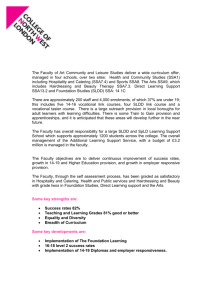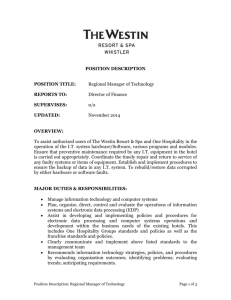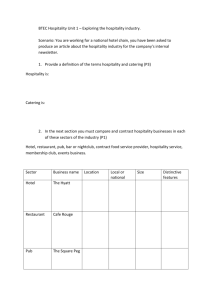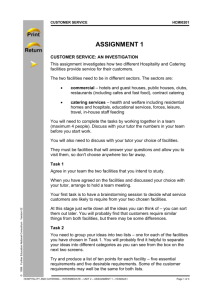PRODUCT COSTING SHEETS
advertisement
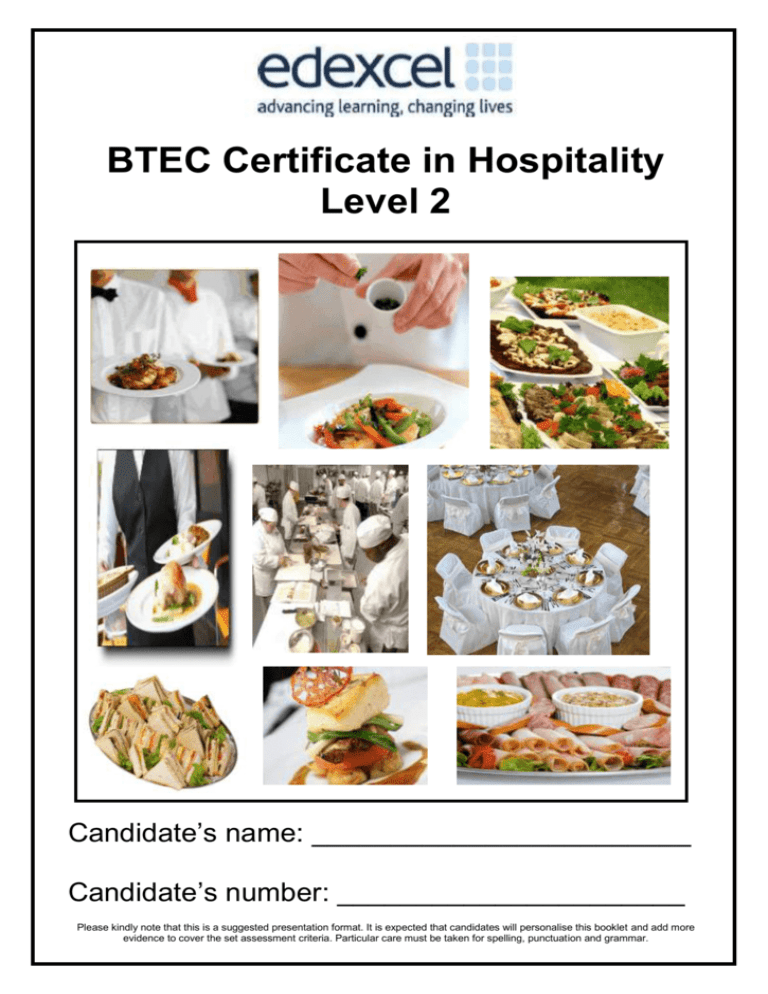
BTEC Certificate in Hospitality Level 2 Candidate’s name: ________________________ Candidate’s number: ______________________ Please kindly note that this is a suggested presentation format. It is expected that candidates will personalise this booklet and add more evidence to cover the set assessment criteria. Particular care must be taken for spelling, punctuation and grammar. UNIT 1 INVESTIGATE THE CATERING AND HOSPITALITY INDUSTRY CREDITS: 4 Candidate’s name: _____________________ Candidate’s number: __________________ Assessment- Unit 1 Title: Investigate the catering and hospitality industry Level: Level 2 Credit value: 4 Assessment Criteria - PASS The learner can: P1: Compare and contrast the features of establishments in hospitality and catering by explaining the different features of the different sectors P2: Assess the impact of key influences on the industry by describing the key influences P3: Describe the terms ‘hospitality’ and ‘catering’ P4: Identify the structure, scope and size of the hospitality and catering industry P5: Describe the key influences on the development of the hospitality and catering industry P6: Explain the differences between types of operations P7: Explain the different features of the commercial and service sectors P8: Explain the importance of the industry to the national economy P9: List the main job roles in catering establishments P10: Explain the difference in staff roles and conditions in the industry including legal requirements P11: Describe the main job roles in a catering establishment P12: Describe the differences in staff roles and conditions in the different sectors P13: Identify the legal requirements to work within the law P14: Identify sources of information about the hospitality and catering industry P15: Describe the functions of professional associations related to catering occupations and describe their functions in relation to national and international context. Ragged Student assessment R A G Teacher checklist (,, ?) = Completed = No evidence ? = Room for improvement (Look at teachers comments, ask for help) LEVEL Name of industry Pub Bar/nightclub Hotel Location Town City Villages Town City Town City Villages Sea side Size Local/ National Services provided 49,000 UK and abroad Alcohol, soft drinks and food 19,000 UK and abroad Alcohol, soft drinks, music/ entertainment 30,000 UK and abroad Food, drink, accommodation This table shows three different establishments; a pub, bar and a hotel and then it explains its location, size, whether they are local or national and then an explanation of the services provided by that establishment. Candidate’s name: _____________________ Candidate’s number: __________________ I got this information from Miss Hopewell’s PowerPoint slide. P1 Compare and contrast the features of establishments in hospitality and catering by explaining the different features of the different sectors P2 Assess the impact of key influences on the industry by describing the key influences Economic: People like the cheaper option this is why many restaurants have vouchers for people to use, as they may not have enough income to pay for the meal and this stops custom. Political: Campaigners now effect the industry. Jamie Oliver made an impact by introducing healthy foods into schools, so the government had to change what schools served up. People are now becoming aware of what they eat. Technological: People can now access food from the internet or mobile phones. Online delivery service is also now available which is becoming very popular so all businesses are feeling they have to keep up and carry suit. Legal influences on the industry: Businesses must meet their legal obligators. The law applies to everyone. The hospitality industry must meet the legal requirements to stay employed. They must keep their workers and customers safe and must not discriminate anyone. Candidate’s name: _____________________ Candidate’s number: __________________ I got this information from the Hospitality BTEC book page 10-11 Social: Social influences concern others attitudes, tastes and opinions. Many people prefer to purchase an organic option and want to know how it is produced. Many businesses are changing due to this. P3 Describe the terms ‘hospitality’ and ‘catering’ Catering: Catering consists of providing food and drink for clients such as in a hospital or prison. Catering can also take place during a theatre or sports venues etc. Candidate’s name: _____________________ Candidate’s number: __________________ I got this information from the Hospitality BTEC book page 4 Hospitality: Hospitality provides accommodation, food and drink, entertainment and other services for guests, visitors, travellers and tourists. The hospitality industry within the UK contains a majority (thousands) of businesses. A vast majority are local and small but some are large and national. P4 Identify the structure, scope and size of the hospitality and catering industry Hotel Pubs Cafes Contract cater McDonalds Food vans Restaurants Budget Restricted clients Hotel YMCA/Charity Restaurants Contract cater Care homes School meals Hospital meals Hotel Airport Cruise ship Casino / bingo Train Golf club Contract cater This is a table that shows the commercial, budget and restricted clients in the hospitality and catering Pubs Pubs provide alcoholic and non-alcoholic drinks and they sometimes provide food. In 2007, there were 57,000 pubs, bars and nightclubs in Great Britain. Restaurants The restaurant sector is the largest part of the hospitality and catering industry. In 2008 there were 70,200 restaurants in the UK. The restaurant industry can be grouped into several categories: fast food, cafes, chain restaurants and fine dining. Hotels The hotel sector of the hospitality industry is large. There are just over 46,000 hotels and guest houses in the UK. Hotels can be grouped into these categories: bed and breakfast, budget hotels and one to five star hotels. This is a table shows the meaning of what a pub, restaurant and hotel is. Size of business: A lot of hospitality and catering businesses are very small and only earn enough money to get by. On the other hand you can get very large chains of businesses such as McDonalds who are multimillion pound operations and employ loads of people. Candidate’s name: _____________________ Candidate’s number: __________________ I got this information from the Hospitality BTEC book page 5-8 and Miss Hopewell’s PowerPoint slide Commercial The economic climate has a direct impact on all industries. If potential customers are earning good wages and their rent or mortgage, and their food, fuel and utility bills are affordable, they will have spare money to spend. This is called disposable income. There are many things competing for this disposal income. For example, you might spend your spare money on: -Music downloads -DVD’s. -Games -Clothes -New gadgets -Going out We all make choices about how we spend our money. These are influenced by the media, by our friends and by our particular interests. The hospitality industry is also subject to many influences. Hospitality businesses must take these influences into account when planning their operations and delivering their services. Candidate’s name: _____________________ Candidate’s number: __________________ I got this information from the Hospitality BTEC book page 10-11 P5 Describe the key influences on the development of the hospitality and catering industry P6 Explain the differences between types of operations All the services that you are going to see are run differently to the different types of services that are provided. This table shows what a one star all the way to a five star hotel should have: Often situated near major motorways and offer simple, basic accommodation. Restaurants are often located nearby and room service is not available. Two star Often situated near office parks, airports, shopping and retail areas. Rooms are comfortably decorated but not elegant. They do not have restaurants or room service but offer free parking and sometimes a swimming pool. Three star Often situated near motorways, in city centres and suburbs. Rooms and reception areas are nicely furnished and offer a degree of comfort. Facilities may include swimming pools, room service, fitness centres and parking. Four star Offer comfort, class and quality that customers can rely on. The hotel will usually be situated in prime location near to desirable shops and restaurants. Facilities may include valet parking, concierge service, room service, well equipped fitness centres. Five star First-class services and accommodation with elegant and luxurious surroundings. The hotel restaurants often have famous chefs with a high standard of cuisine. Self Catering: Properties have to provide the following before they can be considered for a star rating: A high standard of cleanliness throughout The prices and conditions of booking made clear Local information provided so that customers make the most of their stay Comfortable accommodation with a range of furniture to meet customer needs Colour TV at no extra charge Kitchen equipment to meet essential needs Food, beverage and fine dining: Going places like this are more of a sit down restaurant type of setting, where you are served at the table making it more relaxed and therefore needing more staff. It will be more expensive and you will get better customer service. Counter service/fast food: You are looking at places like Sainsbury's café, Costa coffee, colleges, schools, KFC etc. These types of operations provide minimal customer service as customers have to collect their own food and providing they do, customers also clean up after themselves meaning that minimal staffing is required. Takeaway/delivery: This is where you collect food and take it home to eat or you can order it over the phone and get it delivered to your door. These places usually don’t offer a sit down service and there is less staff needed. Meaning the food is usually cheaper than a restaurant and you get the same thing for your money. Candidate’s name: _____________________ Candidate’s number: __________________ I got this information from Miss Hopewell’s PowerPoint slide. One star P7 Explain the different features of the commercial and service sectors This table shows what the different types of commercial and service sectors: Service • Hotels • Hostels • Contract caterers, such as events • Tourist attractions • Hospitals • Prisons • Colleges • Workplace including armed forces catering Profit making • Most! Working to a budget • Prison • Care home catering • NB: Workplace is often also subsidised. • Some organisations are a charity, e.g. YMCA General public • Hotels Restricted customers • Train, cruise and ferry catering • Tourist attractions • Casinos The hospitality industry is not just hotels and restaurants. There are 12 other different sectors of the industry: Commercial or service sector Is hospitality the main purpose of the industry? Is it the reason for the industry being there? Then it is a commercial operation. Or, is it there just because a lot of people stay, study or work there (such as a hospital)? In this case, it is a service operation. Profit making or working within a budget Most hospitality operations need to make a profit but some don’t, they just need to keep to a specific budget. For example a lot of school canteens have a budget of 75p food cost per meal per day. In some workplaces, the canteen works to a budget but the prices are then reduced. A cheap lunch is an incentive to work there – a perk of the job. Restricted customers or open to the general public Most hospitality operations can sell to anyone but some are restricted to selling to a small part of the public: customers who are, for example, on the crosschannel ferry or on a train. List four different types of customers that might book into a hotel... 1. 2. 3. 4. Business people Family on holiday Famous people Journalists Candidate’s name: _____________________ Candidate’s number: __________________ I got this information from Miss Hopewell’s PowerPoint slide. Commercial P8 Explain the importance of the industry to the national economy % of employment Per 1,000 resident North East 8 35 London 8 51 North West 8 39 Scotland 9 43 Wales 8 37 N Ireland 7 34 Overall UK 8 39 Direct Hotels Restaurants Catering Events Induced Retail Consumer goods Other services This chart shows different areas of the UK and their employment and resident. Indirect Manufacture of food Business services Agriculture Transport Communications This chart shows what is direct, indirect and induced in the hospitality and catering industry. This chart shows the hospitality turnover compared to other industries in the UK: Sector £ million sales Hotels 6 800 Restaurants 8 000 Quick service 9 000 Pubs 5 500 Leisure 1 900 Healthcare 1 000 Education 1 200 MoD 200 This table shows the food and drink sales in the UK. I got this information from Miss Hopewell’s PowerPoint slide. Area of UK 1. Catering Manager/Head Chef 2. Restaurant manager 3. Pastry Chef/patissier 4. Larder chef 5. Sauce Chef 6. Vegetable chef 7. Assistant Chef 8. Kitchen Porter 9. Head receptionist 10. Assistant receptionist 11. Porter 12. Night Porter 13. Restaurant Supervisor 14. Head waiter/ess 15. Conference Manager 16. Head House keeper 17. Chambermaid 18. Maintenance officer This is a list of all the catering jobs in the industry. Candidate’s name: _____________________ Candidate’s number: __________________ I got this information from Miss Hopewell’s PowerPoint slide. P9 List the main job roles in catering establishments P10 Explain the difference in staff roles and conditions in the industry including legal requirements Staff roles – a basic outline - Operation or general managers are in charge and run the business. They have overall responsibility of the business. - Unit or department managers are below them. They will direct the staff. - The supervisor and sous chef report to the unit manager. They are given instructions from the unit manager. - Operative staff carry out the day-to-day running of the business. They deal mainly with guests and clients. Operative staff in a hotel include: bartenders, waiters, housekeepers, reception and maintenance staff. Types of workers 1. Agency workers –temporary work through an employment agency 2.Temporary employees – same legal rights as permanent staff. 2 years continuous employment give temporary staff some rights permanent staff have. 3. Casual and Seasonal workers – extra employees are needed at peak times eg Christmas, summer, events. They can have their employment terminated without notice. 4. Continuous employment – have a contract stating pay hours holidays A contract is a legally enforceable agreement between the employer and employee. Continuous employment usually means working for the same employer without a break. The National Minimum Wage The current rate (from 1 October 2010) for the national minimum wage is £5.93 per hour, and now applies to home workers too. Paid Annual Leave All workers are entitled to paid holiday from the day they start work at the rate of 1/2 of their annual entitlement per month worked. Compulsory Rest Breaks Adult workers are entitled to 24 hours off in each 7 day period and young workers (15-18) are entitled to 2 days in 7. Candidate’s name: _____________________ Candidate’s number: __________________ I got this information from Miss Hopewell’s PowerPoint slide. - Craft staff have specialist skills – baker, cake decoration. They take instructions from the supervisor. P11 Describe the main job roles in a catering establishment 1. Hiring, firing, ordering food, menu planning, quantity & quality, health, safety & hygiene, training. 2. Quantity & quality, health, safety & hygiene, training of staff, hosting, seating & greeting and customer service, dealing with complaints. 3. Prepares pastries and deserts. 4. Responsible for cold foods, including salads and dressings, pates, cold hors d’oeuvres and buffet items 6. Prepares vegetables, soups, starches and eggs. Large kitchens may divide these duties among the vegetable cook, the fry cook and the soup cook. 7. Helps in all areas of the kitchen, generally doing the easier tasks. The commis may be completing basic training to become a chef. 8. Cleans up after the chefs, do the washing up and carry goods to and from the store. 9. Is responsible for taking the bookings and ensuring the staff are given the correct information. 10. Assists the head receptionist, helps customers to check in, deals with bills and answers the phone. 11. Delivers cases to rooms and helps in setting up rooms for conferences etc. 12. Covers the receptionist at night and ensures any complaints or queries are dealt with effectively. 13. Is in charge of the restaurant. The manager takes bookings, relays information to the head chef and ensures the restaurant runs smoothly. 14. Is the second in charge of the restaurant. They greet and seat customers and relay information to the staff. They may also deal with complaints. 15. Is responsible for organising conferences for groups and making sure the groups needs are met on the day. 16. Responsible for seeing that all the rooms are ready for customers, completing rotas for staff, telling staff what rooms need to be cleaned. 17. Cleans the rooms, changes the beds, checks that there are enough toiletries, clean towels etc. 18. Completes any repairs that can be done in-house and gets in specialist maintenance staff when required. On P9, is a list of all the catering jobs in the industry and this page shows what the job roles are. Candidate’s name: _____________________ Candidate’s number: __________________ I got this information from Miss Hopewell’s PowerPoint slide. 5. Prepares sauces, stews and hot hors d’oeuvres and sautés foods to order. This is usually the highest position of all the stations. P12 Describe the differences in staff roles and conditions in the different sectors Manager/ supervisor Cleaners/ Assistant Head chef/cook supervisor Commercial sector Bar staff tends to either be full time, part time or seasonal staff. Bar staff tend to work shifts from mornings to late nights when the pub opens and closes. Managers in hotels tend to leave the minor jobs to the supervisors to make sure that the staff do the correct times. Managers tend to work 9-5 jobs. Cleaners/ housekeepers tend to work in shift patterns throughout the day making sure all the cleaning around the hotel is done. Head chef works from the early hours in the morning to start prepping for the day ahead and works on the basis or cooking to order. Service sector In the service sector there are no pubs so there isn't the need for bar staff. Supervisors in the service sector tend to work mostly 4 hours a day as they only really supervise what happens in the kitchen. Assistants in the kitchen mainly cut up all the vegetables and help around the kitchen as well as keeping the kitchen clean and tidy where possible. Cook supervisors normally work 2-4 hours a day cooking breakfast and lunch and they would usually have a set menu and cook in bulk for usually around 500 people. This table shows the different staff roles and conditions. Candidate’s name: _____________________ Candidate’s number: __________________ I got this information from Miss Hopewell’s PowerPoint slide. Staff Bar staff P13 Identify the legal requirements to work within the law Health & Safety at Work Act (1974) Employer must: • Decide what could harm you in your job and the precautions to stop it. • Give you the health and safety training you need to do your job. • Provide you with any equipment and protective clothing. • Provide toilets, washing facilities and drinking water. • Provide adequate first-aid facilities. The Control of Substances Hazardous to Health Regulations (2002) COSHH covers the use and storage of dangerous substances. Examples of potentially dangerous substances include: • • • • • • • • Cleaning fluid. Chemicals. Products containing chemicals. Products that produce fumes. Dusts. Vapours. Mists and gases. Biological agents (germs). The manual Handling Operations Regulations (1992) Lifting safely During the working day, some hospitality employees may need to lift heavy items such as: • Big saucepans full of water. • Making beds requires bending. • Lifting crates. • Employees need to be trained to lift these items properly so that they do not injure themselves. Candidate’s name: _____________________ Candidate’s number: __________________ I got this information from the Hospitality BTEC book page 28-32 The Working Time Regulations (1998) • The working time regulations set rules for the number of hours that can be worked in a week, about entitlements to rest breaks and about the organisation of the working week. • There are specific rules about Sunday working and night working and about overtime work and employing part-time workers. Under this legislation, employees also have some rights to request time for training. P14 Identify sources of information about the hospitality and catering industry Job advert from the Leicester Mercury: Chef De Partie Location: Leicestershire Job Type: Permanent Date Posted: 20-Mar-2012 00:00Add to My Shortlist 'The Crown Inn' at Anstey was opened in early January 2010 and offers a varied and changing fresh menu based on locally sourced produce, along with great wines, cocktails and real ales. We are looking to recruit an ambitious individual, keen to progress their career within the industry. We require a Chef De Partie to join us in this established venture. Job advert from the KFC website: Restaurant General Manager – Derby Date Posted: 20/12/2011 Town/Area: Derby Region: Derbyshire Department: Restaurant Management KFC is looking to recruit a Restaurant Manager for the Derby area. Our restaurants are run by people who know and love the restaurant business. We are looking for leadership at every level and as an Restaurant General Manager you will be responsible for supporting and leading your team in the smooth running of your store. KFC has developed a support structure that celebrates the Restaurant Manager. Among the best rewarded Restaurant Managers in the industry each is equipped to train and motivate with generous programs that assist them in creating unprecedented team environments. KFC knows the secret of motivating teams - which can be fun for everyone and contribute to strong sales growth and great customer service. Job advert from the Jobsite website: Development Chef Salary: £22k - £28k pa + Excellent Location: South West Job Type: Permanent Date Posted: 15-Mar-2012 17:35 Are you the passionate, foodie chef that we are looking for? Do you have pastry / patisserie expereince? We have a specific vacancy for a Junior Development Chef to join a very successful NPD team. Working for an experienced NPD Manager you will bring your creativity and chef knowledge. Put simply this is a massive opportunity for a current Junior Development Chef to make a step into a major, cash rich company who possess a great portfolio of products and customer. For the right person we will offer training and support to a Junior Development Chef who will work with passion and pride, someone able to transfer their culinary talents to a new environment. Candidate’s name: _____________________ Candidate’s number: __________________ I got this information from a newspaper and the internet: Jobsite and KFC Reporting to: head Chef & Sous Chef Responsible for: Commis Chef & Kitchen Assistants. Detail: Full Time Position. £7.00 per hour. 45 hours a week. Benefits: The Fat Cat Group a full range of benefits and entitlements. Location: The Crown Inn, 148 Bradgate Road, Anstey. Leicestershire LE7 7FB British Hospitality Association (BHA) • This is the national trade association for restaurants, catering and hotel. This association has been running for over 100 years. Its main role is to lobby government across the UK and Europe and to represent the opinions of the hospitality industry. Association of valuers of licensed property • This association offers its clients access to specialist/professional advice from surveys or valuers when they want to buy a hospitality property. They will check if the building is safe and suitable enough to run a business from. They will also identify any problems such as dry rot. Association of licensed multiple retailers (ALMR) • The ALMR is the association that represents the interest of the smaller independent retailers and industry supply companies that own and operate pubs, bars and restaurants in the UK. British institute of innkeeping (BII) • This association has two roles. The first is to represent the licesnsed retail sector such as bars and pubs. The second is to raise professional standards through its training and awarding body. Candidate’s name: _____________________ Candidate’s number: __________________ I got this information from the Hospitality BTEC book page 34-35 P15 Describe the functions of professional associations related to catering occupations and describe their functions in relation to national and international context
